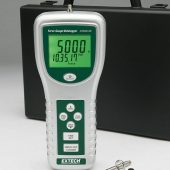A nitrogen regulator ensures a controlled supply of nitrogen gas from a cylinder.
Nitrogen cylinders are typically under very high pressure, with some cylinders having pressure as high as 3,000 psi when full.
Connecting systems and equipment directly to the cylinder valve can be a safety hazard or damage the equipment. It’s also inefficient and can lead to wasted gas.
Most applications where nitrogen gas is needed, whether it’s HVAC purging, laboratory, or industrial manufacturing, have specific pressure requirements.
A nitrogen regulator ensures gas flow stays within the required range.
In some cases, it’s a legal requirement to use a regulator with high-pressure gas cylinders. So before you decide you don’t need a nitrogen regulator, check your local laws.
Can You Use a Nitrogen Cylinder Without a Regulator?
You can use a nitrogen cylinder without a regulator, but it’s not always safe or legal.
Some equipment is designed for direct connection to a cylinder. Confirm with the manufacturer or the product’s user manual that this is safe to do before you go ahead with it.
But most equipment and systems need gas delivery within a certain pressure range. Delivering too little or too much pressure can cause damage or cause a malfunction.
A regulator not only ensures that gas is flowing at the right pressure, it also maintains gas flow at a constant pressure so you don’t get any changes in flow rate.
Which Regulator Do I Need for a Nitrogen Cylinder?
Look for a regulator designed specifically for nitrogen gas. Because different gasses have varying densities, regulators are gas-specific.
Some nitrogen regulators can also be used for argon.
One way to check for compatibility is to check the CGA number on the regulator. For nitrogen cylinders, you need a CGA-580 regulator.
When shopping for a nitrogen regulator, the main differentiating factor among different models is the maximum pressure.
Pricier nitrogen regulators can handle a higher outlet pressure (ideal for connecting to large high-pressure cylinders) and can deliver gas at a higher pressure as well (suitable for high-pressure applications).
The difference between cheaper and premium regulators is especially notable when it comes to delivery pressure.
Most regulators can handle a pressure of 3500-4000 PSI from the cylinder. But cheaper regulators can deliver only up to about 400 PSI, while premium regulators can deliver nitrogen at a pressure as high as 800 PSI or more.
Consider the highest pressure you’ll likely ever need in your line of work, and get a regulator that can deliver it.
How to Install a Nitrogen Regulator
Secure the cylinder on a cylinder stand or against the wall using a chain or strap.
Remove the cap from the cylinder and inspect the valve outlet to make sure it is free of debris. Open the valve just a bit and then close it again to let off a short burst of air. This clears any remaining dust and debris.
Next, inspect the regulator for signs of damage and debris. Focus on the connections as that’s where leaks can occur.
Also, make sure you have the right regulator by checking the CGA number or confirming that it’s meant for use with nitrogen.
Connect the regulator to the cylinder outlet by threading the nut by hand. Before tightening the regulator, make sure the gauges sit at a slight angle to make them easy to read.
Use a smooth jawed wrench to tighten the regulator nut until it is snug.
Check that the regulator valve is closed, then loosen the regulator handle or key until it turns freely. This ensures gas does not flow out when you turn on the cylinder valve.
Now, slowly turn on the valve cylinder. The needle of the first gauge should go up to indicate air getting out of the cylinder.
Connect your equipment to the regulator valve, then start tightening the regulator handle until you achieve the required delivery pressure.
For more help fitting a regulator to a nitrogen cylinder, here’s a step by step video.
How to Check a Nitrogen Regulator for Leaks?
If a regulator leak is bad, you’ll hear gas escaping. But tinier leaks are easier to miss and can be a safety hazard.
Once you connect the regulator and equipment, it’s important to check for leaks. The easiest way to do this is using a liquid leak detector. The best one for most gas cylinders is Snoop.
Apply the liquid around all the connections and see if bubbles form. If there are bubbles, indicating a leak, stop using that regulator immediately.
Can I Transport a Cylinder With the Regulator Attached?
This is a mistake many professionals make, especially those who travel a lot for their work. They’ll often leave the regulator attached to the cylinder while driving around.
The danger with this is that, even if the cylinder is secure, it could still move around and the regulator could hit something or the side of the vehicle.
It’s worse if the cylinder is not secure. If it falls over, the regulator could get damaged.
A damaged cylinder is more likely to leak or show faulty readings. It takes less than a minute to disconnect a nitrogen regulator.
Shut off the regulator valve and remove the attached hose or line. Next, shut off the cylinder valve. Open the regulator valve to release any gas that’s remaining in the regulator. Both gauges should drop to zero.
Use a smooth jawed wrench to loosen the regulator nut, then unscrew it fully with your hand. Store the regulator somewhere safe, ideally in a pouch or case where it’s protected from impact, dust, and moisture.


